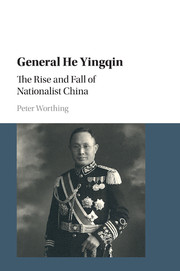Book contents
- General He Yingqin
- General He Yingqin
- Copyright page
- Contents
- Maps
- Book part
- Introduction
- 1 Life and death in a Kunming teahouse
- 2 “Like Bao Shuya and Guan Zhong”
- 3 TheEastern Route Army in the Northern Expedition
- 4 “WithoutChiang Kai-shek, there is no He Yingqin!”
- 5 Reorganizationand its discontents
- 6 Tradingreputation for time
- 7 “Aforce for a hundred-year war of resistance”
- 8 “Maybe now the fire is hot enough to fry Ho Ying-ch'in!!!!”
- 9 “A tall building on shifting sands”
- Conclusion
- Bibliography
- Index
- References
Bibliography
Published online by Cambridge University Press: 05 March 2016
- General He Yingqin
- General He Yingqin
- Copyright page
- Contents
- Maps
- Book part
- Introduction
- 1 Life and death in a Kunming teahouse
- 2 “Like Bao Shuya and Guan Zhong”
- 3 TheEastern Route Army in the Northern Expedition
- 4 “WithoutChiang Kai-shek, there is no He Yingqin!”
- 5 Reorganizationand its discontents
- 6 Tradingreputation for time
- 7 “Aforce for a hundred-year war of resistance”
- 8 “Maybe now the fire is hot enough to fry Ho Ying-ch'in!!!!”
- 9 “A tall building on shifting sands”
- Conclusion
- Bibliography
- Index
- References
- Type
- Chapter
- Information
- General He YingqinThe Rise and Fall of Nationalist China, pp. 279 - 294Publisher: Cambridge University PressPrint publication year: 2016



